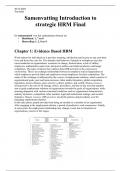30-11-2023
Tim Smits
Samenvatting Introduction to
strategic HRM Final
De tentamenstof voor het eindtentamen bestaat uit:
- Hoofdstuk: 1, 7 en 8
- Hoorcollege 1, 2, 8 en 9.
Chapter 1: Evidence Based HRM
Work matters for individuals as it provides meaning, satisfaction and income to sup- port their
lives and those they care for. The attitudes and behavior of people in workplaces may also
cause headaches in organizations: resistance to change, demotivation, a lack of skilled
employees, authoritarian supervisors and power politics can hinder productive and happy
workplaces. The topic of interest for evidence-based HR activities is the employment
relationship. This is an exchange relationship between an employee and an organization in
which employees provide labor and employers reward employees for their contribution. The
nature of the exchange is influenced by the context of employment relations, which consists of
organizational goals, peer and team processes, labor market dynamics, global competition,
legislation, power relations, and a society’s culture, politics, and wealth. Human resource
management is the sum of all strategy, policy, procedures, and day-to-day acts that together
aim to guide employment relations in organizations towards the goals of organizations, while
ensuring alignment with various contextual conditions such as organization characteristics,
industry dynamics, competition, labor markets, legal and institutional settings, and societal
dynamics. Human resource (HR) practices are all the policies and procedures used for
managing employment relations.
In the entry phase, people develop from being an outsider to a member of an organization.
After engaging in the employment relation, a period of productive work commences. Finally,
at some point, the employment relationship may change or end, due to transitions in
organizations, careers or life stages.
,The more decision-makers understand the recruitment aims, the means and characteristics of
the organization and its context, and the effectiveness of various recruitment tools, the better
these choices will be, thus resulting in a recruitment approach that will bring a good quality
pool of applicants.
Hence, quick fixes are risky decisions that can do as much harm as doing nothing at all. Even
worse, in the rush of solving the next issue, a quick fix is seldom evaluated for its benefits,
thus increasing the risk that the same faulty solution will be recycled a next time.
The origins of evidence-based management
Evidence-based management advocates that practitioners do some research into the nature of
a problem, gather information from different sources within the organization and from experts
and research sources before they suggest an intervention.
One strategy is that researchers make more of an effort to explicate the practical implications
of their findings and to make these available for practitioners. Most scientific journals
nowadays ask researchers to do so.
Another strategy to bridge the science-practitioner gap is co-creation. A scientific study in
which practitioners are closely involved in the design and execution of the research in their
work contexts leads to learning on both sides.
Evidence-based HRM is a specification of evidence-based management principles to the
domain of employment relationships. It is a conscientious, explicit, and judicious decision-
making process to address important people- related issues in organizations by combining the
best available research evidence with measurable data and professional knowledge available
in organizations. Core elements in this definition of EBHRM are:
1. It is about decision-making by practitioners who consciously apply their expertise and
judgment.
2. they use evidence from the local context to which the decision applies.
3. they critically evaluate the best available external research evidence.
4. and they take perspectives of people who might be affected by the decision into account.
Hence, specific organizational characteristics (financial means, organization structure, the
type of work) should lead to the selection of specific practices. It is also not about
‘benchmarking’, which essentially holds that practices are com- pared between organizations.
Benchmarking leads to copying HR practices from successful competitors, without much
consideration for the precise needs of the organization.
Decision-making as bounded rationality
Decision-making theories consider the process of actions that lead decision- makers to take a
decision. Strategic decisions involve using resources (time, people, money) and are supposed
to lead to some substantial outcome that matters for (a part of) the organization.
2
, Depending on the school of thought, there are different views on decision- making processes.
The first is rational decision-making theory. Rational means that decision makers who engage
in a decision-making process first have an idea about what they want to achieve with the
decision and then use some methodology to gather appropriate information and weigh various
alternatives before deciding on the best solution.
In 1947, Herbert Simon therefore introduced the concept of bounded rationality. According to
bounded rationality theory, individuals are able to take rational decisions within the limits of
their preferences, their social position and their understanding of the problem and the
alternative solutions. Opposite to rationality is irrationality. Bounded rationality suggests that
it is possible to take the best decision given an imperfect understanding of reality.
To conclude, evidence-based management and its application in human resource management
provide a process to make better strategic decisions about people in workplaces under
conditions of bounded rationality. The process is flexible and accounts for iteration, where
information in each phase may require adjustment of the previous step. Ultimately, evidence
based HRM policies and practices will contribute to improved performance of organizations,
better alignment of organizations with their contexts, and ultimately to the well-being of
employees.
The evidence based HRM process
process part 1: asking a focused question.
The first steps in the process are exploring the problem and determining the problem
statement. This involves asking questions such as ‘What is the problem?’, ‘What should be
solved?’ and ‘Which outcomes are at stake?’ It also implies exploring the context of the
problem, by asking critical questions about its relation to organizational values, stakeholder
views and organizational politics. The first task here is to define the outcome as specifically
as possible. An example of a focused problem statement could be: ‘How can learning and
3





